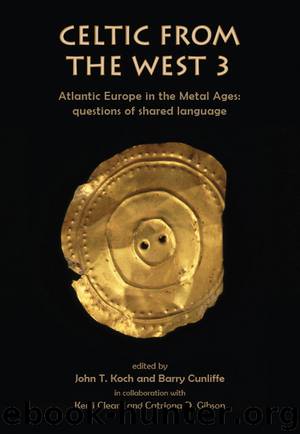Celtic From the West 3 by Unknown

Author:Unknown
Language: eng
Format: epub
Tags: HISTORY / Europe / General
ISBN: 9781785702280
Publisher: Casemate Publishers & Book Distributors, LLC
Published: 2016-09-02T00:00:00+00:00
Interpretation
From the evidence currently available, it seems clear that the site of Meillionydd was continuously and quite densely occupied over an extended period of time, stretching from, at least, either the latest Bronze Ages or earliest Iron Age to the Middle Iron Age and possibly even somewhat later than that. The density of occupational features makes it likely that we have to assume at least several hundred years of continuous occupation of the site, possibly as much as half a millennium or even slightly longer. It started out as an open settlement of timber roundhouses clustered around the top of the spur on which the site lies, was later enclosed and then monumentally enclosed, a pattern generally well-known from other British sites, and especially other sites in north Wales. Sometime later, the enclosing banks became at least partly defunct and obliterated by roundhouses being built into and on top of them, a sequence of development that exactly mirrors that at the closest site of the same type, Castell Odo, just a few miles away and intervisible with Meillionydd. Finally, the site was abandoned, but only after it had been ‘buried’ in an elaborate and quite labour-intensive closure rite.
This implies that there were significant changes in the conceptualization and—as a consequence of this—structuration of (a particular kind of) settlement space happening during this period on the Llŷn Peninsula. These changes, however, seem to have affected or applied to only some homesteads or households, not all of them: it seems as if it became at least desireable, if not socially necessary, that some settlements—usually such that lie in prominent locations, in elevated positions with wide views over the surrounding landscape (and, in case of Penllŷn, possibly also the surrounding seascape)—were physically separated from their surroundings by some kind of enclosure, and later not just any kind of, but a monumental enclosure. The same did not seem to be desireable or necessary for many others, which continued as either entirely unenclosed, or differently structured, possibly lightly enclosed settlements (for various types and their distribution see Waddington ibid., 27–87).
This, and the fact that the sequences of the development of Meillionydd and Castell Odo are virtually identical, makes it exceedingly unlikely that the decision to enclose and structure a particular settlement in a particular way was just an arbitrary choice of its inhabitants, but rather makes it very likely that both the act of enclosure, as well as its structure and nature, were socially meaningful choices. Such choices, however, have to be expected to have at least been silently acquiesced with, if not positively sanctioned by, the wider community inhabiting the different kinds of settlements existing in the area. Enclosing a settlement in the way that Meillionydd was thus was a socially meaningful statement, a statement that, most likely, not everyone could equally make.
I would argue the that the reconceptualization of settlements like Meillionydd was a rather fundamental one, a reconceptualization which created a socially meaningful ‘court’, rather than just a purely practical, functional yard.
Download
This site does not store any files on its server. We only index and link to content provided by other sites. Please contact the content providers to delete copyright contents if any and email us, we'll remove relevant links or contents immediately.
The Housekeeper by Natalie Barelli(1490)
Mind to Matter by Dawson Church(1326)
The 2012 Story by John Major Jenkins(1061)
The White Spider by Heinrich Harrer(1027)
The Red Bandanna by Tom Rinaldi(1004)
Tiger Woods by Jeff Benedict & Armen Keteyian(979)
Dreamcatcher by Stephen King(975)
Interesting by Steve Davis(903)
The Blind Side: Evolution of a Game by Michael Lewis(902)
The Wedge by Scott Carney(879)
American Colossus by Allen M. Hornblum(872)
Becoming Johnny Vegas by Johnny Vegas(857)
Play Poker Like the Pros by Phil & Jr. Jr. Hellmuth(832)
When You Dead, You Dead by Guy Martin(826)
Guinness World Records 2014 by Guinness World Records(816)
Nick Hornby(800)
Breaking the Surface by Greg Louganis & Eric Marcus(797)
Deadliest Men by Kirchner Paul(792)
Steinbrenner by Bill Madden(792)
